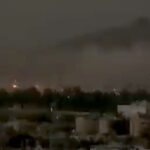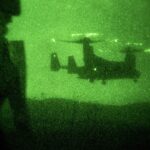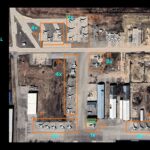The Israeli Air Force (IAF) conducted an night-time raid against IRGC-Quds and Syrian military targets in southern Syria on November 20. The IAF raid was retaliation for the ineffective rocket salvo fired in the previous day from Syria into northern Israel. The IAF likely used its “trademark” attack corridor through Lebanese airspace to fire cruise missiles from stand-off range.
המתיחות בצפון | מערכות ההגנה האווירית של סוריה במהלך תקיפות צה”ל הלילה במדינה @LiranHaroni pic.twitter.com/o8UCHps1lQ
— חדשות 13 (@newsisrael13) November 20, 2019
IDF Spokesman Brig.-Gen. Hidai Zilberman revealed the tens of targets were struck in Damascus, west of Damascus and the Syrian Golan Heights overnight, belonging both to the regime of Bashar Assad and the IRGC’s external branch, the Quds Force. According to the British-based Syrian Observatory for Human Rights, 23 people, including 16 non-Syrians, most likely Iranians, were killed in the Israeli airstrikes. Given the high-number of IRGC casualties and magnitude of the attack, Iran is expected to retaliate militarily against Israel.
PRELIMINARY-BATTLE DAMAGE ASSESSMENT
The P-BDA sourced by the Israeli geospatial company ImageSatIntel shows that the IAF targeted key position in Damascus International Airport and Mezzeh airfield. This was the first time since the IAF’s covert air campaign commence seven years ago, that the IRGC’s Command & Control (C2) center in Syria was attacked. While the “Glasshouse” is still standing, its northeastern corner was leveled by a precision airstrike.
Thread – 2/4: The #Iran|ian #QudsForce HQ in #Damascus intl. airport, AKA the #Glasshouse. Before and after #Today‘s airstrike.#IMINT #ISI #satellite #intelligence #space pic.twitter.com/NZIS2THn4L
— ImageSat Intl. (@ImageSatIntl) November 20, 2019
The five floor monolith building was used since the early years of the Syrian Civil War by IRGC officers – namely from Quds Force – to command and control assets, coordinate intelligence collection activities and direct military operations. However, we assess that Tehran re-deployed most of its departments and senior commanders to other, more secure locations in Syria as the “Glasshouse” became increasingly known to international press, foreign intelligence and OSINT collectors.
Thread – 4/4: #IRGC/Quds Force HQ in #AlMazzeh airport, #Damascus. Before and after #Today‘s airst
rike.#IMINT #ISI #satellite #intelligence #space pic.twitter.com/ZbZl2pBo0l— ImageSat Intl. (@ImageSatIntl) November 20, 2019
Judging by the large explosions followed by secondaries seen in the videos shared online, the IAF most likely also hit ammunition depots, vehicle shelters and logistics nodes.
More from yesterday’s (20 November) strike in #Syria: A covered parking lot destroyed within the #Syrian 4th Division Camp, west #Damascus. pic.twitter.com/VF94TdJ7k7
— ImageSat Intl. (@ImageSatIntl) November 21, 2019
As seen countless times before, the Syrian Arab Air Force (SyAAF) was unable to prevent or impede the Israeli missiles from reaching their targets.
- Russia Bombs Maternity Ward & Children’s Hospital in Mariupol As Part of Siege - 10 March 2022
- T-Intell’s OSINT Training Marks One Year Anniversary - 18 November 2021
- IS-K Never Left the Battlefield - 27 August 2021






